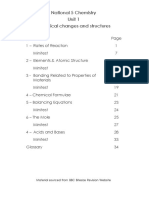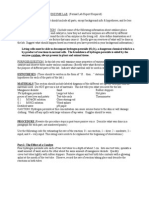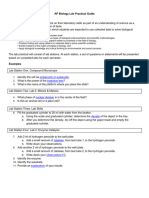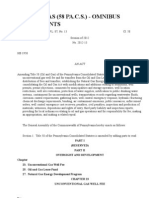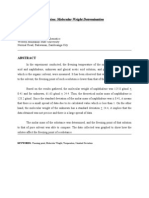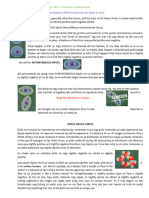Enzyme Lab
Enzyme Lab
Uploaded by
RicardoCopyright:
Available Formats
Enzyme Lab
Enzyme Lab
Uploaded by
RicardoOriginal Description:
Copyright
Available Formats
Share this document
Did you find this document useful?
Is this content inappropriate?
Copyright:
Available Formats
Enzyme Lab
Enzyme Lab
Uploaded by
RicardoCopyright:
Available Formats
LAB #10
Title: ENZYMES
Aim: To investigate how pH, temperature, substrate concentration and enzyme concentration
affect the activity of the catalase enzyme.
List all apparatus and materials used.
Method:
1. Remove the skin of the potato and cut into minute pieces. Homogenize with an equal
volume of water in a blender.
2. Dice the liver and homogenize with distilled water in a blender.
3. Place 1cm3 of liver into boiling tube A (take the pH using pH paper) and add 5cm3 of
hydrogen peroxide.
4. Quickly place a rubber bung connected with tubes over the boiling tube and place the
open end of the tube into a tube of water. Ensure that the rubber bung or tube does not
come into contact with the testing solution.
5. Count the number of bubbles produced in a one minute.
6. Repeat the procedures 3-5 using the potato.
7. Record all observations and results.
8. Place 1cm3 of liver and potato into boiling tubes C and D then add 8 cm3 of hydrogen
peroxide. Place the rubber bung over the tube and count the number of bubbles
produced.
9. Place 1cm3 of liver and potato into 2 different labelled boiling tubes.
10. Expose boiling tube E and F to 65⁰c water bath for 2 minutes. Remove from heat;
allow cooling and adding 5cm3 of hydrogen peroxide.
11. Quickly place a rubber bung connected with tubes over the boiling tube and place the
open end of the tube into a tube of water.
12. Count the number of bubbles produced in a one minute.
13. Place 1cm3 of liver and potato into 2 different labelled boiling tubes.
14. Add 1cm3 of HCl to boiling tube G and H. Take the pH of each solution. Add 5cm3 of
hydrogen peroxide to each tube.
15. Quickly place a rubber bung connected with tubes over the boiling tube and place the
open end of the tube into a tube of water.
16. Count the number of bubbles produced in a one minute.
17. Tabulate all results.
Diagram: set up of apparatus.
Description of the reaction which occurred as soon as the hydrogen peroxide was added to
the tissue and oxygen evolution under each condition for both liver and potato.
State the control used and the manipulated variables in each experiment.
Discussion:
Give background information on enzymes e.g. what it is, how it works, factors which
affect its functioning.
Say that catalase is found in both liver and potato.
Reaction broke down hydrogen peroxide into water and oxygen (state in worded and
chemical equation form).
Bubbles represented the bubbles formed which indicated the rate of production of
oxygen hence the breakdown of hydrogen peroxide.
Were the results expected? Why?
Theoretically what are the known concentrations of the enzyme in both potato and
liver. Relate to results (in experiment A, did the liver or potato produce the higher
number of bubbles? Why?)
Use the first experiment (5cm3 of hydrogen peroxide at RT and pH 6) of liver and
potato for comparisons – experiment A.
Compare results of potato and liver when temperature and pH were varied with
experiment A. For example, when temperature increased, the number of oxygen
evolved decreased from 127 in experiment A to 20.
Why did results vary in varying conditions, that is, how did each condition affect the
activity of the enzymes. Mention activation energy, kinetic energy, active site, bonds
in enzyme structure.
Sources of Error, Precautions taken, One Limitation must be stated.
Criteria : A / I Marks Awarded
A Definition of related terms such as what is an enzyme and how do they 1
work.
B Briefly discussing relevant theory of experiment such as what type of 1
reaction occurs between catalase and hydrogen peroxide, what type of
gas is the bubbles, what factors affect enzyme activity.
C State the theoretical basis of the experiment. 1
D Describing appropriate trends 1
If only data / Tables / graphs stated award 0 mk only
Discuss fully what is the relationship between the results and the aim
Giving full details of what the results were in relation to background
theory.
Points should address comparison between experiments and why the
results were expected (relate to bonds affected within protein
structure of enzyme)
E Temperature 1
F pH 1
G Substrate and enzyme concentration 1
H Explanation of limitations / precautions / sources of error that may 2
have impacted the lab in some way.
(1mk each)
I Reflection stated- how can the experiment be changed and improved 1
J Conclusion should be a Concise summary statement 1
K Conclusion Must be related to the aim 1
TOTAL 12
POSSIBLE
MARKS
You might also like
- Unit 3 MCQDocument13 pagesUnit 3 MCQMajd Haddad100% (1)
- Enzyme Kinetics Lab ReportDocument20 pagesEnzyme Kinetics Lab ReportYasmin Lau100% (2)
- DIAGNOSTIC TEST IN TLE 9 With TOSDocument5 pagesDIAGNOSTIC TEST IN TLE 9 With TOSErwin Poblete Ararao95% (21)
- (1123) Nat 5 Unit 1 RevisionDocument35 pages(1123) Nat 5 Unit 1 Revisions9dijdjiNo ratings yet
- Investigating Factors Affecting The Rate of Photosynthesis: QuestionsDocument3 pagesInvestigating Factors Affecting The Rate of Photosynthesis: QuestionsChin CustodioNo ratings yet
- The Effect of Substrate Concentration On The Activity of EnzymesDocument7 pagesThe Effect of Substrate Concentration On The Activity of Enzymesjosephine100% (1)
- Lab09 Catechol OxidaseDocument9 pagesLab09 Catechol Oxidaseastromaze10No ratings yet
- Enzyme Catalase Lab ReportDocument2 pagesEnzyme Catalase Lab ReportRizziel Nemes50% (2)
- Lab 8 Che506Document17 pagesLab 8 Che506Aeyrul KhairulNo ratings yet
- O Level Biology Practice Questions And Answers EnzymesFrom EverandO Level Biology Practice Questions And Answers EnzymesRating: 5 out of 5 stars5/5 (1)
- 03 EnzymesDocument3 pages03 EnzymesyezzromaulNo ratings yet
- SPM Operational DefinitionDocument6 pagesSPM Operational DefinitionMark CwmNo ratings yet
- Noa, Joanne, Chloe, Elysia - Lab 1 - Enzyme LabDocument5 pagesNoa, Joanne, Chloe, Elysia - Lab 1 - Enzyme Labnono.sq21No ratings yet
- Laboration - Biokemi Enzymer KatalasDocument30 pagesLaboration - Biokemi Enzymer KatalasAyla AlijaniNo ratings yet
- Catalase Enzyme Lab (2022)Document5 pagesCatalase Enzyme Lab (2022)lindldus000No ratings yet
- Lab 3 KineticsDocument6 pagesLab 3 KineticsMichelle SamayoaNo ratings yet
- 1B. Enzyme Activity (Oxygen) : BackgroundDocument6 pages1B. Enzyme Activity (Oxygen) : BackgroundSiegNo ratings yet
- 4 t2.5 Comp EnzymesDocument4 pages4 t2.5 Comp EnzymessushantNo ratings yet
- BIO121 - Experiment 4Document7 pagesBIO121 - Experiment 4Tan Ri ShenNo ratings yet
- Guide Questions For All ExperimentsDocument7 pagesGuide Questions For All ExperimentsRomar Angelo AvilaNo ratings yet
- Shared Copy L Enzymes Lab.Document20 pagesShared Copy L Enzymes Lab.desirechristianforeverNo ratings yet
- Che311 1Document112 pagesChe311 1flowealthNo ratings yet
- 15bgal PDFDocument8 pages15bgal PDFRaul Enrique Carrasco ConchaNo ratings yet
- C STR Kinetics 2012Document12 pagesC STR Kinetics 2012JpojNo ratings yet
- Properties of EnzymesDocument7 pagesProperties of Enzymeslcassidy9074No ratings yet
- 9.2.1.a Most Organisms Are Active in A Limited Temperature RangeDocument10 pages9.2.1.a Most Organisms Are Active in A Limited Temperature RangeTroy SouthwellNo ratings yet
- uow195619Document4 pagesuow195619yuzhangqinNo ratings yet
- Iodinization of AcetoneDocument15 pagesIodinization of AcetoneThanh LanNo ratings yet
- Biology Enzyme LabDocument4 pagesBiology Enzyme LabMaya PlewniaNo ratings yet
- Enzyme LabDocument4 pagesEnzyme LabvincentmdNo ratings yet
- Enzyme Worksheet Grade 11 1Document6 pagesEnzyme Worksheet Grade 11 1vincenuque03No ratings yet
- 08 Morgan Carter Lab4 WorksheetDocument6 pages08 Morgan Carter Lab4 Worksheetsrahimi@verizon.netNo ratings yet
- Lab 8 Enzyme KineticsDocument5 pagesLab 8 Enzyme KineticsSiti Mastura Abdul RahmanNo ratings yet
- Kinetics Expt 4-2011Document7 pagesKinetics Expt 4-2011Wilo JaraNo ratings yet
- Exercise 11Document3 pagesExercise 11api-270901668No ratings yet
- Chapter 8 Lecture-Energy, Enzymes, and Metabolism-MODIFIED2Document49 pagesChapter 8 Lecture-Energy, Enzymes, and Metabolism-MODIFIED2E'Lasia Larkin100% (1)
- Lab 13 Enzymes Reading PDFDocument8 pagesLab 13 Enzymes Reading PDFLarryDengNo ratings yet
- Lab Report RubricDocument2 pagesLab Report Rubricjenh191No ratings yet
- AP Biology Lab Practical Guide A Lab Practical or Exam Tests ...Document4 pagesAP Biology Lab Practical Guide A Lab Practical or Exam Tests ...marisa corderoNo ratings yet
- Enzyme ExperimentDocument6 pagesEnzyme ExperimentBill HarleyNo ratings yet
- Bio Project (Enzymatic Reaction) by Sayan MukherjeeDocument20 pagesBio Project (Enzymatic Reaction) by Sayan Mukherjee9994739572sayanNo ratings yet
- I Odin Ization of AcetoneDocument15 pagesI Odin Ization of AcetoneanfatallaNo ratings yet
- Enzyme Lab 2012Document5 pagesEnzyme Lab 2012huki johnNo ratings yet
- Grob 2006Document6 pagesGrob 2006noviNo ratings yet
- 5180 445-001 YewDocument39 pages5180 445-001 YewEZEKIEL OPARANo ratings yet
- PAG4.1 Student The Effect of Substrate CDocument3 pagesPAG4.1 Student The Effect of Substrate CAmaniNo ratings yet
- Investigation On Enzyme Activity and KineticsDocument25 pagesInvestigation On Enzyme Activity and KineticsJu DeckNo ratings yet
- Catalase Lab 2014 Key 23Document6 pagesCatalase Lab 2014 Key 23kyungsoo studiesNo ratings yet
- 123Document6 pages123Julius Rafael Delprado DildigNo ratings yet
- Biological Activity and Variation of Toxicity of Probenecid-IJACS-2018Document7 pagesBiological Activity and Variation of Toxicity of Probenecid-IJACS-2018Soumen BhattacharjeeNo ratings yet
- Enzymes Virtual LabDocument4 pagesEnzymes Virtual Labapi-34000547527% (11)
- Iodine Clock A2 CourseworkDocument7 pagesIodine Clock A2 Courseworkafjwsbgkjdhkwz100% (2)
- Investigating The Effect of Temperature & PH On Enzyme ActivityDocument3 pagesInvestigating The Effect of Temperature & PH On Enzyme Activityjuliakang03No ratings yet
- Catalase LabDocument7 pagesCatalase LabToga BrandonNo ratings yet
- RE2 Kinetic Study of Ethyliodide and NaOH in A Batch ReactorDocument4 pagesRE2 Kinetic Study of Ethyliodide and NaOH in A Batch ReactorMarcel LinaNo ratings yet
- Enzyme LabDocument5 pagesEnzyme LabJane ChongNo ratings yet
- Science 10 Q4 Module 7 8Document19 pagesScience 10 Q4 Module 7 8Dennis Douglas Alo Jr.No ratings yet
- Gen Chem 2 Q2 Module 14Document19 pagesGen Chem 2 Q2 Module 14Evelyn AndosonNo ratings yet
- Enzyme Catalysis Lab ReportDocument5 pagesEnzyme Catalysis Lab ReportfikarisvitaNo ratings yet
- Lab Manual March 2023Document23 pagesLab Manual March 2023MASYITAH MOHD PADZILNo ratings yet
- Physico-Chemistry of Solid-Gas Interfaces: Concepts and Methodology for Gas Sensor DevelopmentFrom EverandPhysico-Chemistry of Solid-Gas Interfaces: Concepts and Methodology for Gas Sensor DevelopmentNo ratings yet
- Model 201B PID FID NDUV 511Document10 pagesModel 201B PID FID NDUV 511Dr. John Jack DriscollNo ratings yet
- Pharmaceutical Jurisprudence and Relevant Administrative Order - HANDOUTDocument38 pagesPharmaceutical Jurisprudence and Relevant Administrative Order - HANDOUTsandrock9920058942No ratings yet
- Feed Tank and Pressure SizingDocument4 pagesFeed Tank and Pressure SizingodvutNo ratings yet
- Surface orDocument2 pagesSurface orDaniel MaxNo ratings yet
- Effect of Post Weld Heat Treatment On The Oxide Scaling of Cr-Mo Steel WeldmentsDocument7 pagesEffect of Post Weld Heat Treatment On The Oxide Scaling of Cr-Mo Steel WeldmentsFebriant SchweinsteigerNo ratings yet
- Oil and Gas (58 Pa.C.S.) - Omnibus AmendmentsDocument76 pagesOil and Gas (58 Pa.C.S.) - Omnibus AmendmentsLeonNo ratings yet
- Pharmaceutical Packing - A Growing PhenomenaDocument18 pagesPharmaceutical Packing - A Growing PhenomenaSiddharth SikariaNo ratings yet
- Analysis On The Spinning Process and Properties of Tencel YarnDocument8 pagesAnalysis On The Spinning Process and Properties of Tencel Yarnkhalil khanNo ratings yet
- Gohi Diori Excursion StudyDocument4 pagesGohi Diori Excursion StudyGohi DioriNo ratings yet
- Gulfpub HP 201204Document139 pagesGulfpub HP 201204BacteriamanNo ratings yet
- Reaction Paper - Water Waster Characteristics and Sewage TreatmentDocument2 pagesReaction Paper - Water Waster Characteristics and Sewage TreatmentChilton John DuatNo ratings yet
- EAS The Effect of Smoking Durations On PH and Sei Meat ProteinDocument9 pagesEAS The Effect of Smoking Durations On PH and Sei Meat Proteinjemmy dethanNo ratings yet
- Good Agricultural Practices For Okra: Thai Agricultural Standard TAS 2501-2005Document25 pagesGood Agricultural Practices For Okra: Thai Agricultural Standard TAS 2501-2005MichaelNo ratings yet
- Axial SpA Guideline 2019 ACRDocument15 pagesAxial SpA Guideline 2019 ACRTurboNo ratings yet
- Xifa BrandDocument6 pagesXifa BrandGuybrush TripweedNo ratings yet
- Full Repot Total SolidDocument14 pagesFull Repot Total SolidSyafiq Azman100% (1)
- Synsafe RevoDocument8 pagesSynsafe Revodallo64No ratings yet
- MWDDocument6 pagesMWDSharmaine Manahan-SipinNo ratings yet
- ALS Mine Site Laboratory Services - GoldDocument12 pagesALS Mine Site Laboratory Services - GoldSrikanth Jutru100% (1)
- Wunda Size MSDSDocument5 pagesWunda Size MSDSkolumboNo ratings yet
- Guide Intramolecular Forces Are Forces Within A MoleculeDocument2 pagesGuide Intramolecular Forces Are Forces Within A MoleculeMaria CongNo ratings yet
- Coconut Haustorium Maintains Cardiac Integrity andDocument6 pagesCoconut Haustorium Maintains Cardiac Integrity andSpv PPICNo ratings yet
- The Disadvantages of Fly AshDocument8 pagesThe Disadvantages of Fly AshShariar Masud TowhidNo ratings yet
- The Cost of Beauty: by Kamarul Aznam Kamaruzaman Published 4 Years AgoDocument6 pagesThe Cost of Beauty: by Kamarul Aznam Kamaruzaman Published 4 Years Ago115trezNo ratings yet
- Digestibility Determination in Fish Using Chromic Oxide Marking and Analysis of Contents From Different Segments of The Gastrointestinal TractDocument8 pagesDigestibility Determination in Fish Using Chromic Oxide Marking and Analysis of Contents From Different Segments of The Gastrointestinal TractRafael Hamakawa ViannaNo ratings yet
- Mdbsis09 CA A III 2017Document4 pagesMdbsis09 CA A III 2017Guneyden GuneydenNo ratings yet
- Spanish Vineyard Tour 2011 - CatalogueDocument21 pagesSpanish Vineyard Tour 2011 - Catalogue黃郁心No ratings yet
- Qna - D-F Block ElementsDocument27 pagesQna - D-F Block ElementsbrrrrrrrrrrrrruNo ratings yet



